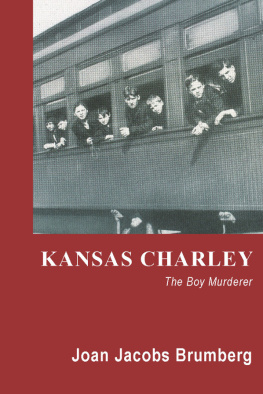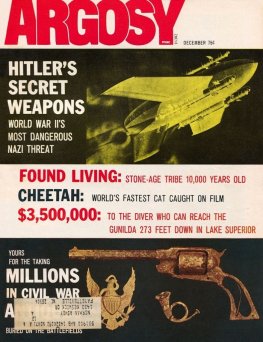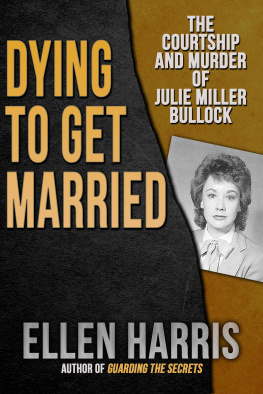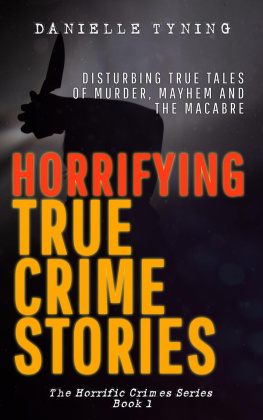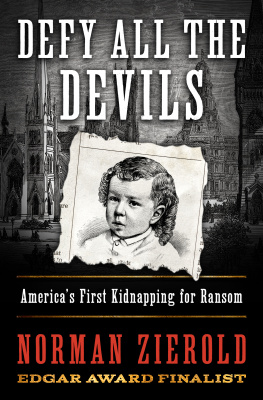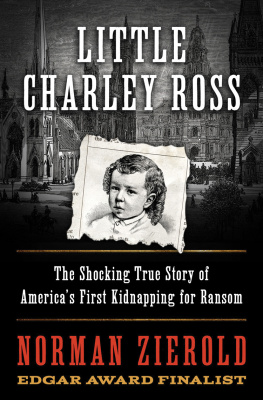There is an entire series of difficulties directly traceable to the foolish and adventurous persistence of carrying firearms . What might be merely a boyish scrap is turned into tragedy because some boy has a revolver.
Jane Addams, The Spirit of Youth and the City Streets, 1909
Murder is murder, and I myself believe that the murder the State does in punishment of killing is the worst murder of all.
William Dean Howells, HarpersWeekly, 1895
The Light of Lights
Looks always on the motive, not the deed,
The Shadow of Shadows on the Deed alone
W. B. Yeats, The Countess Cathleen, 1909
In writing this book I owe an enormous debt to two historians who are part of my everyday lifemy husband, David Brumberg, and my longtime friend Faye Dudden. Both listened to my relentless chatter about Charley long before I had a coherent story to tell. And both also wrestled with chapters in the rough, bringing me to the mat with their individual knowledge and insight about nineteenth-century America. David graciously traveled with me to places that were not exactly holiday destinations and then joined me in the archives looking for traces of Charley Miller. Faye endured long lunches at which I ruminated periodically about the mind-set of a fifteen-year-old boy.
When I needed help making sense of what happened to Charley in court, Anu Chaturvedi Connor and Anjali Charurvedi, both Cornell alumnae and attorneys, pitched in. Because Anu was once my undergraduate student, her collaboration as a young professional felt especially sweet to me. When I needed advice about a rhetorical strategy for the book, I was also fortunate to be able to turn to my own undergraduate teacher and mentor, Bernard Weisberger, an octogenarian who is also a prolific writer and historian. His savvy advice about the structure of my narrative pointed me in the right direction, just as he had in my college days with undergraduate papers. In the early stages of research, Larry Brown, Wyomings resident expert on Charley Miller, was consistently generous in answering questions and directing me to sources; Lois Brown, Frederick Hodges, Joseph Kett, Roger Lane, Philip Mackey, Eric Monkkonen, Michael James Pfeifer, and Bill Pretzer each answered my questions promptly (and electronically) when the moment was right. Paul and Ellen Grebinger read a problematic chapter for me in the midst of an Adirondack vacation. And when the manuscript was nearly done, I profited from astute readings by Steven Drizin, Nina Miller, Phil Roberts, Carla Bittel, Victor Streib, Nancy Tomes, and Randolph Werner.
There are many people at Cornell University who helped make this book possible, and also better. Within the Cornell University Library System, I am indebted particularly to Michael Cook, Julie Cophenhagen, Lenore Coral, Patricia Court, Brandy Kreisler, Robert Kibbee, Ida Martinez, Fred Muratori, Suzanne Schwartz, Susan Szasz Palmer, and Donald Schnedeker for their consistent, skillful assistance. In thinking about the psychological development of a boy like Charley Miller, I profited from lively conversations with Wendy Williams, Howard Feinstein, Steve Ceci, and James Garbarino, intellectually generous colleagues who were especially interested in a project that brought psychology and history together. Jan Jennings and Kathleen Gibson introduced me to the world of Internet searching. Carolyn Merrithew and Mary White provided able research assistance, however briefly, and a number of Cornell undergraduatesSomjen Frazer, Jillian Greenberg, Leigh McMullan, Jennifer Scheff, Carolyn Stein, and Amy Stutiushelped me in myriad ways over the four years it took to produce this book. Production of the manuscript was assisted by my longtime secretary Jolan Balog, but also by Benjamin Rockey-Harris, an undergraduate, whose enthusiasm for Macs and his cheerful willingness to make an occasional house call got me through some technological crises. I am also grateful to everyone in University Photography at Cornell who helped me reproduce visuals for this book.
Charley Millers story spanned the continent, requiring me to travel and also to get some research assistance. While I was in Cheyenne, Sharon Lass Field actually came into the State Archives to help me dig for answers to my questions about local women, but I am also indebted to Julie Curry, a Cornell graduate student, who conveniently became a visiting member of the history faculty at the University of Wyoming. Julie served as my eyes and ears when I had last-minute questions about Wyoming material, and she did so with an unsparing attention to detail and accuracy. I am grateful to others in Wyoming: to Holly Geist and Cindy Brown at the Wyoming State Archives; to Carol Bowers and Leslie Shores at the American Heritage Center; to Tony Lewis at the Wyoming Bar Association; to Gary C. Anderson and Linda Newell at the Johnson County Jim Gathcell Memorial Museum; and to Betty Schroll, historian of St. Marys Parish.
In New York City, Victor Rehmer at the Childrens Aid Society graciously opened the archives for my pursuit of Charley and his siblings; Julie Miller shared her knowledge of custodial institutions for children in that city; and Megan Elias did some searching for me in the municipal archives. In Philadelphia, Jessie Bluebond-Langner skillfully gathered information about Holmesburg Prison; in Boston, Elyssa Engelmann did some local research about a juvenile homicide case in that area. Nancy Martin at the University of Rochester was an invaluable guide to sources in that city, as was Terry Lehr, who shared ideas about local materials. Donald Moore helped me find information about Charleys adopted family in Virginia.
As a I moved into the Midwest in pursuit of Charley, I got the opportunity to meet some of the people who had been helping me at a distance, often electronically. In Ohio, Denise Montbarren at the College of Wooster provided useful responses to my requests. In Missouri, my queries were answered by Jackie Lewis at the St. Joseph Museum and Mary Beth Rowe at the River Bluffs Regional Library. Paul Lubotina, William Glankler, and Suzanne Lehr all provided brief research assistance. In Kansas, a number of archivists gave generously of their time: Pat Patton at Kansas State University; Linda Glasgow at the Riley County Historical Society; and Jane Kelsey and Susan K. Forbes at the Kansas State Historical Society. I am especially grateful to Linda Glasgow for providing access to Phyllis Swanson, who invited me to her home in Leonardville to talk about the history of the town and what she had heard about Charley Miller from her own grandparents, who lived there at the same time as Fred Miller. Mary Clement Douglass helped me trace a number of Kansas women who were involved in the story. My knowledge of Charleys experience in Minnesota was enhanced by assistance from Howard Sanborn at the Filmore County History Center; Kathy Schuler at the Winona County Historical Society; Nancy MacMahon at the Chatfield Historical Society; Maurice Bennett at the Olmsted County Historical Society; and Charles Rodgers, Debbie Miller, and Jennifer Hanson at the Minnesota Historical Society in St. Paul. Dallas Lindgren provided useful research support in the early stages of the Minnesota investigation. In Iowa, Catherine Denial briefly gave me some useful research assistance. In Nebraska, Ann Billesbach at the Nebraska State Historial Society; Catherine Renschler at the Adams County Historical Society; and Ada Ammerman and the Research Team at the Cheyenne County Historical Association in Sidney were all extremely helpful.

